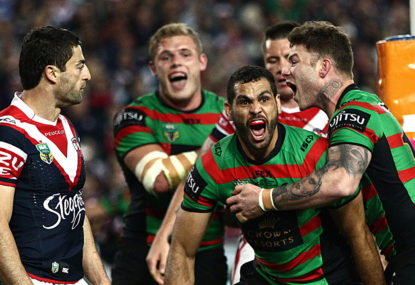'Brushed the Eighth like a booger': Freddy's amusement at Jamal Fogarty disagreeing with Joey
Andrew Johns thought he came up with a smart piece of analysis, only to be taken down by the Raiders halfback, then his own…

The World Club Series has been hugely successful in 2015, with three gripping ties folding out between the English and Australia rugby league clubs.
St George Illawarra edged out Warrington 18-12 in a gruelling encounter, Brisbane beat Wigan in an extra-time thriller 14-12, which was decided by a penalty goal, while the NRL premiers South Sydney humiliated the Super League premiers St Helens 39-0.
Three huge matches, all in front of sell-out crowds.
When the tournament was first announced I had two trains of thought on the concept. The first was that the World Club Series would take the spotlight off the World Club Challenge. In a way it did, with two tough and gruelling matches overshadowing a complete blow-out. However, it didn’t take the tradition away from the match.
The second train of thought was simply that there was more pre-season footy to watch. I found myself hauling myself out of bed for three consecutive mornings to watch so-called ‘friendlies’, but as we all saw they were anything but.
Now I have a completely different train of thought regarding the tournament. Can the World Club Series replace the NRL pre-season? The answer is simple. Yes, it can.
A knock-out tournament will be staged between all teams from the NRL and Super League, excluding the premiers of both competitions, who will later compete in the World Club Challenge. This means that a total of 26 teams will compete over a five-week period.
For the first round, all teams will be drawn except for those clubs that finished second, third or fourth on the NRL or Super League tables. The first round will feature 20 teams competing in 10 matches over a four-day period.
The second round will feature the winners of the first round ties as well as the clubs which were given the bye for the first round. This round will feature 16 teams who will compete in eight matches over a four-day period.
The third round will follow with the winners of the second round proceeding. The competition will be reduced to eight teams and will be the final round before the play-offs.
The semi-finals will be played between the winners of the third round matches. These two games will be the qualifying matches for the World Club Series final.
The final will wrap-up the tournament with the two winners of the semi-finals competing for the World Club Series trophy. The match will be followed by the World Club Challenge between the NRL and Super League premiers.
While the tournament is taking place the touring premiers will remain in their home country and participate in community carnivals and continue their pre-season training before flying out for the World Club Challenge.
The tournament will alternate hosts each year between Australasia and Europe. It will replace the current NRL pre-season structure in which clubs have the option of scheduling pre-season trials against other NRL, New South Wales Cup or Queensland Cup teams.
Hasn’t this been done before?
In 1997, all 22 clubs from the Australasian and European Super League championships contested the World Club Championship over six rounds in two hemispheres. It didn’t turn out well with an estimated five million dollar loss due to poor ratings and attendances.
This time around, however, the NRL and RFL will not make the same mistakes. This competition, unlike the previous, will take place in one region (Australasia or Europe) rather than in two hemispheres. The tournament will also feature high quality rugby league and close contests between each club, as has been shown in the 2015 World Club Series.
Television ratings will be strong, especially in the host region. Matches will be taken away from the big grounds (ANZ Stadium, Suncorp Stadium and Old Trafford etc) and will be taken to smaller grounds which do not normally host matches between elite teams (North Ipswich Reserve, Belmore Sports Ground, Caltex Oval and Langtree Park etc). Hence, creating a sense of occasion and delivering good crowds while strengthening the game’s relationship with these areas, especially in the NRL’s case with country areas.
The television broadcasters will no doubt jump aboard this concept. Twenty-five games will be played throughout the tournament (excluding the World Club Challenge) meaning the networks would have access to a large catalogue of matches. Although the tournament will alternate between Australasia and Europe each year, making viewing times difficult for both regions, the broadcasters will still reach a large audience if matches are played in the morning.
Added to this, the networks will also get to show the tournament in their own market at prime time bi-annually, which will result in large ratings and more revenue for the game. The tournament will couple with the huge broadcast rights deal and add to the value of the next deal.
The competition will take place two weeks after the NRL Auckland Nines and upon their return the teams will participate in the NRL Community Carnival a week before the opening round of NRL action. I think we may well have just fixed the NRL pre-season. It’s up to you, Roarers.